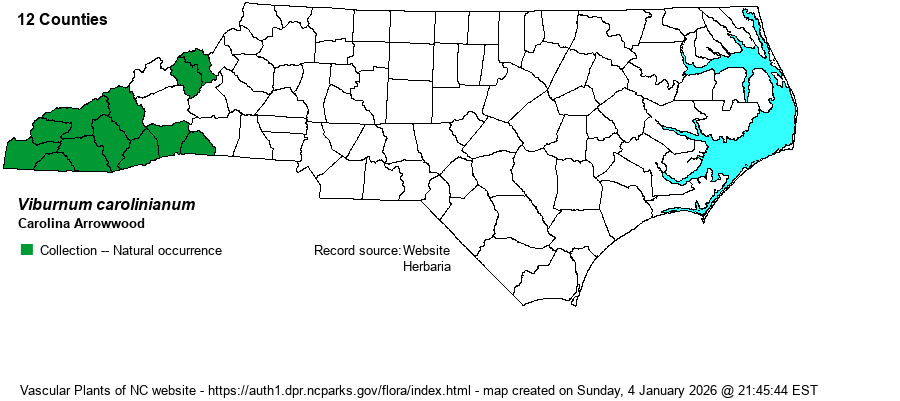| Author | Ashe | |
| Distribution | Occurs in the southern Mountains north to Mitchell County, and east into the Piedmont of Polk County. [Note: On the range map in RAB (1968), this species is that portion of “Viburnum dentatum” occurring in the Mountains.]
This recently split species has a small range, found only in southwestern NC, and in adjacent TN and GA. It may well occur in northwestern SC, but there are no known records for that state.
| |
| Abundance | Apparently uncommon to fairly common, at least in the southern Mountains, as it has been found in all counties north to Haywood County and east to Polk County. Perhaps rare to uncommon north to Mitchell County. The website editors suggest a State Rank of S3?; the species is not in the NCNHP database. | |
| Habitat | This species occurs both in uplands and in moist forests. It can be found in upland forests, often in rocky areas, but it seems to be most numerous along forested stream banks. Much more information is needed on this taxon regarding habitat and abundance. | |
| Phenology | Blooms in April and fruits from July to September. | |
| Identification | This is a medium-sized shrub with deciduous, opposite leaves, growing to 6-9 feet tall. It is a split of the Viburnum dentatum complex, and thus it has widely ovate, if not almost rotund, strongly toothed leaves growing to about 3 inches long. According to Weakley’s (2018) key, this species can be separated from V. recognitum, the only other member of the V. dentatum complex within its NC range, by its rotund leaves vs. ovate [narrower] in V. recognitum and by its pubescent/hairy leaves all over the underside, as opposed to hairs only in the vein axils and on a few veins in V. recognitum. Viburnum rafinesqueanum and true V. dentatum essentially occur only to the east of V. carolinianum, though the latter has some sites within the southern mountains. Carolina Arrowwood can be told from V. dentatum (strict sense) by its thick leaves with strong/deep veins and more hairiness on the underside of the leaves; the latter has thin leaves and not deeply set veins, and the pubescence is not dense. | |
| Taxonomic Comments | Quite a few references do not have this species split out from V. dentatum, including NatureServe (and thus the N.C. Natural Heritage Program). Thankfully, the iNaturalist website does consider this as a valid species. The best treatment is found in Weakley (2020-2024), based on the draft document prepared for FNA by B.A. Sorrie.
| |
| Other Common Name(s) | None? | |
| State Rank | [S3?] | |
| Global Rank | GNR [G5] | |
| State Status | | |
| US Status | | |
| USACE-agcp | | |
| USACE-emp | | |

